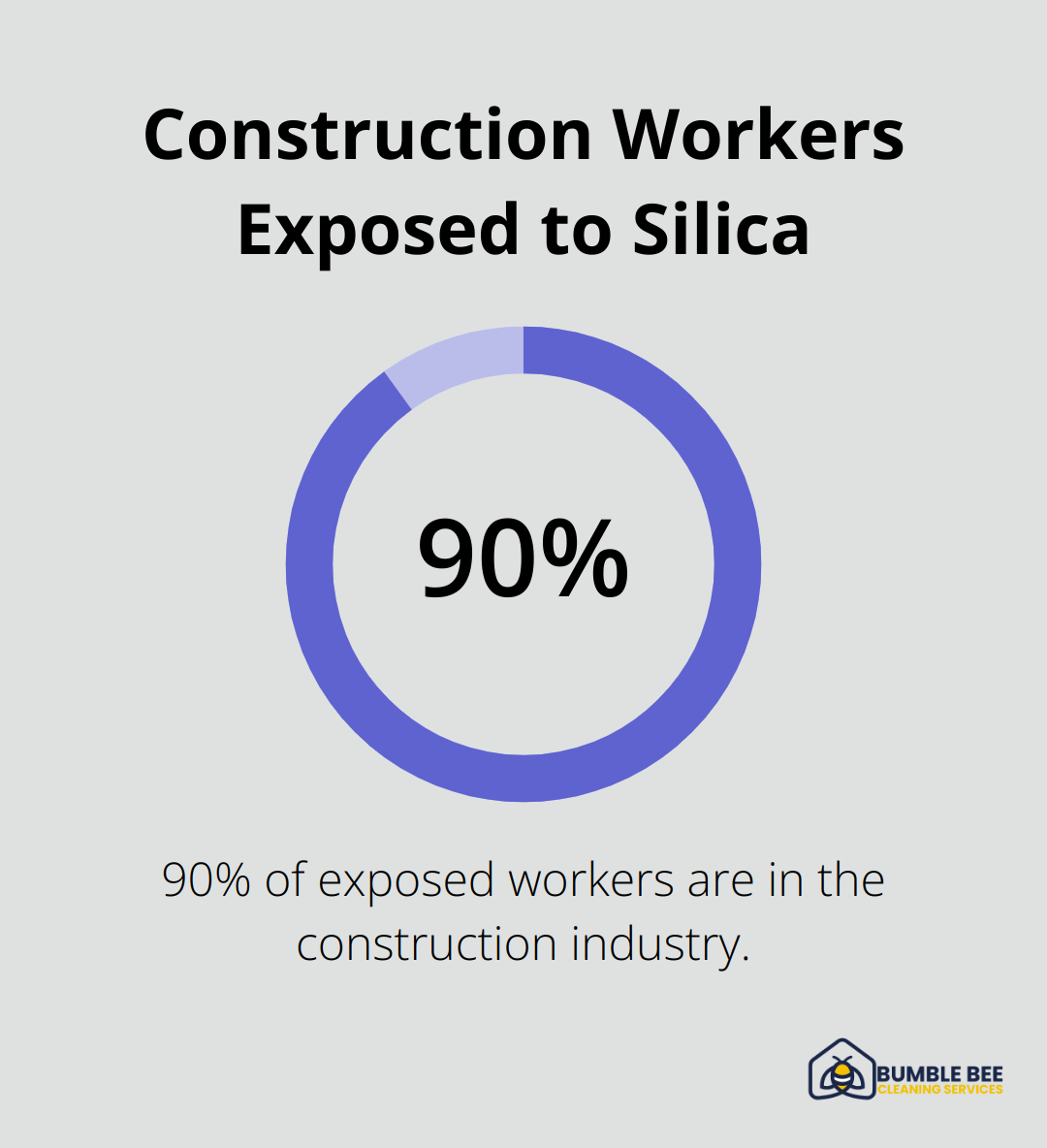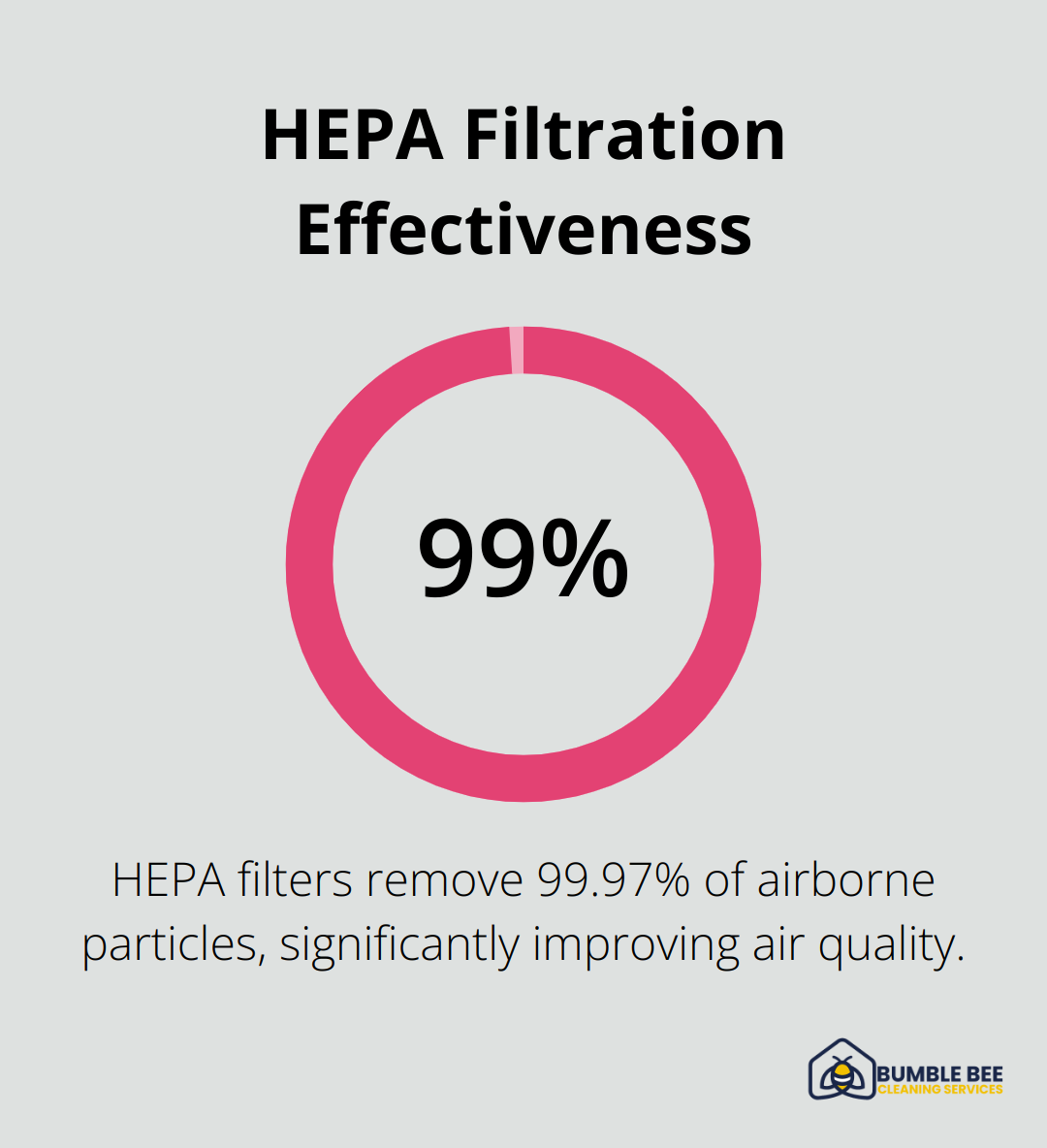Construction debris poses hidden dangers in Seattle homes that many homeowners overlook. From health risks to environmental impacts, the aftermath of renovations can be more hazardous than you might think.
At Bumble Bee Cleaning Services, we’ve seen firsthand the potential risks associated with improperly managed construction waste. In this post, we’ll explore these dangers and discuss professional solutions to keep your home safe and clean.
What Are the Health Risks of Construction Debris?
Construction debris in Seattle homes poses serious health hazards. The Occupational Safety and Health Administration (OSHA) reports that approximately 2.3 million construction workers face exposure to respirable crystalline silica, with 90% of those in the construction industry. This statistic highlights the widespread nature of the problem, which extends beyond workers to homeowners and their families.
Respiratory Dangers from Dust and Particulates
One of the most significant risks comes from the inhalation of dust and particulates. Post-construction dust contains a harmful cocktail of substances. Fine particles from drywall, cement, and wood can remain airborne for days, posing potential respiratory dangers. The Environmental Protection Agency (EPA) emphasizes that thorough cleaning after renovations maintains indoor air quality. Prolonged exposure to construction dust can cause chronic respiratory issues, including bronchitis and potentially even lung cancer.

Exposure to Hazardous Materials
Older homes in Seattle may contain hazardous materials. Federal law requires contractors, property managers, and others who are being paid to take precautions when disturbing lead-based painted surfaces. The Seattle & King County Public Health department recommends professional cleaning services to remove hazardous dust from renovations in older homes safely. Asbestos, another dangerous material often found in older buildings, causes serious lung diseases if its fibers become airborne during construction or demolition.
Physical Injuries from Debris
Sharp objects and unstable piles of debris present immediate physical dangers. Nails, broken glass, and splintered wood cause cuts, punctures, and other injuries. Unstable debris piles shift unexpectedly, leading to falls or crush injuries. These hazards concern homes with children or pets particularly.
Mitigation of Health Risks
To address these risks, proper cleaning and disposal methods prove essential. HEPA filtration systems remove 99.97% of airborne particles, which significantly improves indoor air quality post-renovation. Professional cleaning services use specialized equipment and techniques to address these hazards effectively.

The health risks associated with construction debris extend beyond immediate physical dangers. The long-term effects on respiratory health and exposure to hazardous materials underscore the importance of proper post-construction cleaning. This leads us to consider the broader environmental impact of improper debris disposal, which affects not only individual health but also the community at large.
How Construction Debris Harms Our Environment
Construction debris poses significant environmental threats when improperly disposed of. The impact extends far beyond the immediate construction site, affecting soil, water, wildlife, and contributing to landfill issues.
Soil and Water Pollution
Improper disposal of construction waste leads to soil and water contamination. The Environmental Protection Agency (EPA) states that construction activities release harmful chemicals and materials into the ground. These contaminants seep into soil and groundwater, potentially affecting drinking water sources and agricultural land.
In Seattle, frequent rainfall carries runoff from construction sites into local waterways. The Washington State Department of Ecology identifies construction site runoff as a leading cause of water pollution in urban areas. This runoff transports sediment, chemicals, and other pollutants into Puget Sound, harming marine ecosystems.
Impact on Local Wildlife
Construction debris negatively affects local wildlife in several ways. Plastic waste from construction sites often ends up in waterways, where animals mistake it for food. The National Oceanic and Atmospheric Administration (NOAA) estimates that millions of marine animals die each year from plastic ingestion or entanglement.
In urban areas like Seattle, construction debris piles become makeshift habitats for pests like rats and raccoons. This increases human-wildlife conflicts and can spread diseases. The Seattle Animal Shelter regularly responds to calls about wildlife trapped in or injured by construction debris.
Landfill Overflow and Waste Management
Construction and demolition (C&D) debris significantly contributes to landfill overflow. In Seattle, the recycling rate fell to 52.7% in 2021, with landfilled waste increasing.

The King County Solid Waste Division provides resources on how to build successful construction and demolition (C&D) diversion programs, design for disassembly, and create C&D waste management plans. Improper disposal not only takes up valuable landfill space but also wastes resources that could be recycled or reused.
To address these issues, Seattle has implemented strict regulations on construction waste management. The city requires contractors to recycle or reuse at least 70% of waste generated on most construction projects. This policy has significantly reduced the amount of debris ending up in landfills.
Proper management of construction debris plays a vital role in protecting our environment. It requires a concerted effort from contractors, homeowners, and cleaning professionals to ensure responsible waste handling. The next section will explore professional cleaning solutions that effectively address these environmental concerns while ensuring thorough removal of construction debris from your Seattle home.
How Professionals Handle Construction Debris
Professional cleaning services address the challenges of construction debris with specialized techniques and equipment. This chapter explores the advanced methods used to safely and effectively manage post-construction cleanup.
Advanced Equipment for Debris Removal
Professional cleaning companies employ state-of-the-art equipment designed specifically for construction cleanup. High-powered HEPA vacuums stand out as essential tools in this process. These vacuums can theoretically remove at least 99.97% of dust, pollen, mold, bacteria, and any airborne particles with a size of 0.3 microns, capturing fine dust and debris that standard vacuums miss.
Industrial-grade air scrubbers also play a vital role. These machines filter large volumes of air, removing airborne particles and improving overall air quality. The Environmental Protection Agency (EPA) recommends the use of air scrubbers in combination with other cleaning methods to maximize debris removal.
Eco-Friendly Disposal and Recycling Practices
Responsible disposal of construction waste forms a key aspect of professional cleaning services. Seattle’s goal is to have 70 percent of all construction and demolition waste recycled or salvaged for reuse instead of ending up in a landfill by 2020. Professional cleaners understand local regulations and work to meet or exceed these requirements.
Many cleaning companies form partnerships with specialized recycling facilities to ensure proper handling of different materials. For example, concrete and asphalt can be crushed and reused in new construction projects, while wood waste transforms into mulch or biomass fuel.
Safety Priorities in Debris Removal
Safety takes precedence when dealing with construction debris. Professional cleaning teams undergo rigorous training in handling potentially hazardous materials. They wear appropriate personal protective equipment (PPE), including respirators, gloves, and safety goggles, to protect against dust and sharp objects.
Cleaning professionals also follow strict protocols for identifying and safely removing hazardous materials like lead-based paint or asbestos. The Occupational Safety and Health Administration (OSHA) provides guidelines for handling these materials, which professional cleaners strictly adhere to.
Specialized Techniques for Thorough Cleaning
Professional cleaners employ specialized techniques to ensure thorough removal of construction debris. These methods include:
- Systematic cleaning approaches (starting from high surfaces and working downwards)
- Wet cleaning methods with damp microfiber cloths to trap dust effectively
- Use of extendable dusters and crevice tools for hard-to-reach areas
These techniques, combined with professional-grade equipment, result in a comprehensive cleanup that DIY methods often fail to achieve.
Expertise in Handling Different Surface Types
Construction debris affects various surfaces differently. Professional cleaners possess knowledge of different surface types and employ appropriate cleaning methods for each. For instance, they use pH-neutral cleaners for hardwood floors to avoid damage, while employing stronger solutions for more resilient surfaces.
This expertise ensures that all areas of a newly constructed or renovated space receive proper treatment, preserving the integrity of new installations while thoroughly removing dust.
Final Thoughts
Construction debris poses significant risks to health and the environment in Seattle homes. Professional cleaning services offer a comprehensive solution to these challenges with specialized equipment and expert knowledge. These services safeguard occupant health, preserve renovated spaces, and contribute to responsible waste management practices.
Bumble Bee Cleaning Services encourages homeowners and contractors to adopt safe and responsible post-construction practices. This includes proper planning for waste management, using appropriate protective equipment during cleanup, and considering professional cleaning services for thorough debris removal. Professional cleaners ensure thorough removal of construction debris while prioritizing safety and environmental responsibility.
The aftermath of a construction project matters as much as the project itself. Proper management of construction debris (including dust, particles, and hazardous materials) ensures that your newly renovated space is not only beautiful but also safe and environmentally sound. Professional cleaning services play a vital role in creating safer, healthier living environments while contributing to the well-being of our community and the planet.
